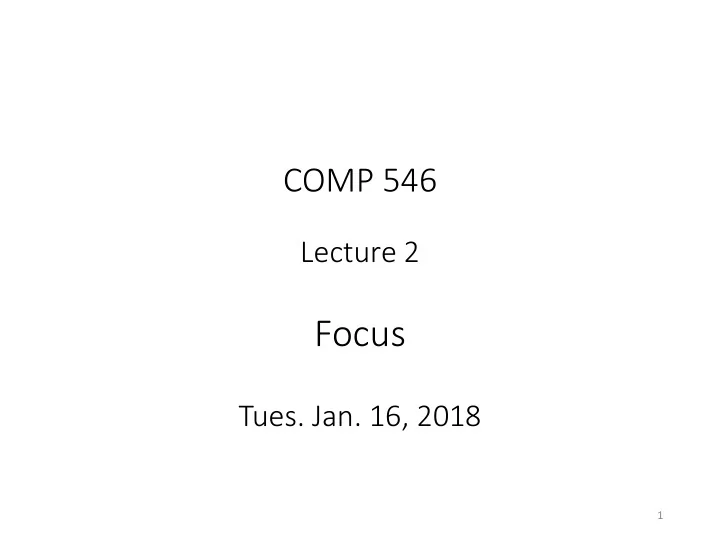

COMP 546 Lecture 2 Focus Tues. Jan. 16, 2018 1
Last lecture • aperture (and f-number) • visual angle • binocular disparity and depth Today • Image sampling • Lenses, blur, focus (accommodation) 2
The ability to see detailed patterns is limited by: - image sampling (density of photoreceptors/pixels) - defocus blur (due to finite size aperture) small aperture 3
Image Sampling assume pinhole camera What is the density of photoreceptors? What is the angle between samples? 4
s = distance (mm) between samples f = diameter of eye 5
s = distance (mm) between samples f = diameter of eye 𝑡 = angle (radians) between samples 𝑔 𝑔 𝜌 = samples per visual angle (degrees) 𝑡 180 6
Defocus blur: two ways to think about it Each image pixel receives light from many scene points. Each scene point sends light that reaches many image points. 7
8
Evolution of the Lens of the Eye http://www.youtube.com/watch?v=mb9_x1wgm7E (Richard Dawkins video) 9
Focal length and power of a thin lens f parallel rays of light f is the focal length 1/f is the ‘power’. 10
Focal length f used in two ways Last lecture: distance from aperture to sensor plane Today: distance behind lens where parallel incoming rays converge (It may not coincide exactly with sensor plane.) 11
Conjugate points For every 3D point on one side of a thin lens, the rays diverging from that point will converge at some other 3D point on the opposite side of the lens. 12
Thin lens model 1 1 1 = object distance + focal length of lens image distance 1 Units: is called “diopters” (D) meters 13
Special case: object at infinity 1 1 1 = object distance + focal length of lens image distance f 14
Which scene points are in focus? 1 1 1 = focal plane distance + focal length of lens sensor distance sensor plane focal plane 15
Image Blur sensor plane focal plane 16
Blur and depth beyond closer than at focal plane focal plane focal plane 17
Blur width Blur width is the spread of rays from a scene point on the sensor plane . sensor plane focal plane 18
Exercise Hold up a finger up at arm’s length: 57 cm. Focus at a distance of 10 m. Eye is 2 cm long. Aperture (pupil) is 3 mm. [I am not claiming that the above numbers correspond to this photo.] Q: What is the visual angle of the finger blur width w ? w 19
focal 𝑎 𝑝 = 10 m 𝑎 𝑡𝑓𝑜𝑡𝑝𝑠 = .02 plane thumb .57 𝑎 𝑗 20
focal 𝑎 𝑝 = 10 𝑎 𝑡𝑓𝑜𝑡𝑝𝑠 = .02 plane thumb 𝑎 𝑗 𝑎 𝑢ℎ𝑣𝑛𝑐= .57 Solve for 𝑎 𝑗 21
𝑎 𝑡𝑓𝑜𝑡𝑝𝑠 𝐵 = .003 𝑎 𝑗 = .0207 → 𝑥 ≈ . 0001 𝑛 22
𝑎 𝑡𝑓𝑜𝑡𝑝𝑠 𝑥 1 blur width angle = 𝑎 𝑡𝑓𝑜𝑡𝑝𝑠 ≈ 200 𝑠𝑏𝑒 ≈ .3 𝑒𝑓 23
Exercise: show that blur width (in radians) is: focal plane 24
The aperture (pupil) is the hole in the iris. The iris is in front of the lens. For simplicity, I will not draw the iris in the remaining figures. 25
Depth of Field Depth of field is the range of depths that are perceived to be in focus. (In fact, only one depth is in perfect focus. ) 26
Depth of Field “Just noticeable” blur In focus “Just noticeable” blur focal plane 27
Typical depth of field in human vision is said to be about 0.3 diopters (D). But it depends on many factors: - pupil diameter - variations between people - what is the image being judged ? - … 28
Typical depth of field in human vision is said to be about 0.3 diopters (D). But it depends on many factors: - pupil diameter - variations between people - what is the image being judged ? - … NOTE: it does not depend on the depth of focal plane. 29
Examples where depth of field is about 0.3 diopters. 0 .3 D infinity 3.3 m .2 .5 D 5 2 m .7 1 D 1.43 1 m 30
31
Thin lens optics ) ( ( )( ( ) ) 1 1 1 1 1 1 + 2 + 3 + 4 = 𝑔 𝑔 𝑔 𝑔 𝑔 Equivalent power for a single lens 32
1 1 1 𝑔 𝑚𝑓𝑜𝑡 ≡ 𝑑𝑝𝑠𝑜𝑓𝑏 + 𝑔 𝑔 e.g. 40 + 20 = 60 (diopters, D) typical values The cornea has more refractive power than the lens. 33
Accommodation The lens shape can change: muscles squeeze the lens and change its curvature (and power). object focal plane 34
1 𝑔 1 1 1 1 𝑑𝑝𝑠𝑜𝑓𝑏 + 𝑔 𝑚𝑓𝑜𝑡 = 𝑎 𝑔𝑝𝑑𝑏𝑚𝑞𝑚𝑏𝑜𝑓 + 𝑔 𝑎 𝑡𝑓𝑜𝑡𝑝𝑠 Adjusting power of lens changes the focal plane distance object focal plane 35
Presbyopia Older lenses resists shape change. Range of adjustment of lens power (diopters) Age 36
Accommodation & presbyopia age 10 30 50 37
Myopia “short sighted”: can’t focus at infinity cornea power is too high, given size of eye accommodation depth of field 38
Hyperopia “far sighted”: can’t focus on near field lens + cornea power are too low, given size of eye accommodation 39
e.g. I am myopic. My cornea + lens is too strong. )( Lens with negative power 1 1 1 1 𝑔 𝑚𝑏𝑡𝑡𝑓𝑡 + 𝑔 𝑚𝑓𝑜𝑡 ≡ 𝑑𝑝𝑠𝑜𝑓𝑏 + 𝑔 𝑔 - 3 + 40 + 20 D ish ish 40
Corrected Myopia: allows distant vision accommodation )( Far enough! Why? depth of field 41
Corrected Hyperopia: allows near vision accommodation depth of field 42
Open questions • How does the visual system determine if an image is in focus ? (Define blur.) • How does the visual system accommodate ? (Accommodation interacts with binocular vergence) • Is defocus blur a “depth cue” ? 43
Recommend
More recommend